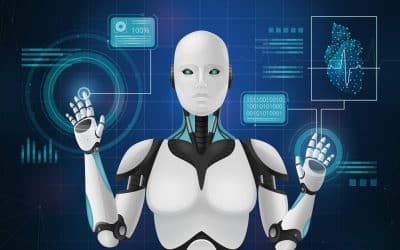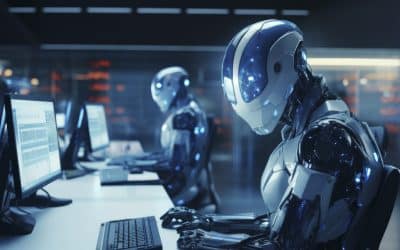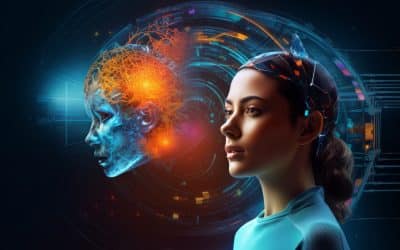In the age of digital change, understanding the technology that drives innovations is no longer an option but a requirement. One tech that is at the forefront of this change is machine learning. Analyzing data and identifying patterns that can be utilized to reach business objectives can be a broad way to define the field of data analytics. However, with the volume of data entering businesses rapidly increasing, the challenge has grown to analyze data using only traditional statistical techniques.
The astonishing capabilities of machine learning algorithms are the basis of the operation of many solid AI systems. They allow systems to understand information, predict, and tackle complex issues without explicit programming. Machine learning algorithms carefully study the data, detect patterns, and offer accurate forecasts and classes, allowing AI systems to increase and enhance their efficiency continually. Machine learning strategies include developing, training, testing, and applying Machine Learning Model. They are now instrumental in developing new technologies and advancements within our increasingly data-driven society. They provide the foundation to solve many complex problems, including speech recognition, image recognition fraud detection, and medical diagnostics.
In this piece, we’ll explore the concept of machine learning and the different machine learning techniques.
What Is Machine Learning?
Machine Learning, commonly abbreviated ML, is an artificial intelligence technique focused on creating computers capable of learning how to improve themselves through experiences with data. These computers will eventually produce applications of this information, which improve over time as their algorithms adjust and gain expertise from previous lessons they receive from learning algorithms. Put, machines can take advantage of data to build predictions or make choices with no explicit programming to perform this task.
In its essence, machine learning focuses on developing and implementing algorithms to help in these kinds of decisions and forecasts. They are created to enhance their efficiency as time passes and become more efficient and accurate when they can process significant amounts of information. In a traditional program, computers follow an established set of instructions to complete a task. In machine learning, however, the computer is provided with a set of instances (data) and a specific task. Still, the computer is responsible for deciding how to complete the task using the given information.
In other words, if we want a computer to identify images of cats, we can give it specific guidelines about a cat’s appearance. Instead, we present it with hundreds of cat images and let the machine-learning algorithm determine the cat’s most common traits and patterns. As the algorithm processes more images and learns to recognize more cats, it becomes more adept at recognizing cat features, even if it is presented with pictures that it has not seen previously. The capacity to learn from data and develop over time makes machine learning extremely powerful and adaptable. This is the main reason behind numerous technological advances, such as voice assistants, autopilot systems, recommendation systems, and advanced analytics.
What Exactly Is An ML Algorithm?
Machine learning algorithms are mathematical guidelines and processes that allow the AI system to accomplish particular tasks, such as forecasting output or making information-based decisions. This is the method by which the machine analyzes and processes data input, detects patterns or connections between the data, and then produces the outcome or forecast. The algorithm was designed to collect valuable data from data inputs and then use that information to draw informed conclusions or forecasts. It is put through a training stage where it learns from an unlabeled or labeled dataset. Each input corresponds to an output that is known or unknowable. During training, the algorithm tweaks its parameters and functions to reduce mistakes and increase performance.
After training, the algorithm may be applied to fresh, unstudied data to make predictions based on the learned patterns. It uses information and patterns to expand and predict the results of new data input. The ability of the algorithm to develop and precisely predict output in the absence of data is the most critical measure of effectiveness.
Machine Learning Techniques are designed for different tasks and data types. Specific algorithms are better suited to solve classification issues when inputs are given to particular groups or categories. To date, some are more efficient in regression in determining numeric values. In addition, algorithms are specifically developed to detect anomalies, clustering recommendation systems, and others.
Machine learning methods are the fundamental part of an AI system. They help the computer gain knowledge from information, detect patterns, and make decisions or predictions based on that knowledge. They’re the primary instrument that allows machines to carry out intelligent tasks and adjust to the changing environment using the information learned from training.
Machine Learning Today
Is machine learning (ML) an entirely new field? It’s not. AI technology has existed for a long time but has only become commercialized recently. This is due to technological advancements, which have improved computing speed and eliminated the cost barrier to deployment. Recent ML versions allow for complex mathematical computations to speed up data processing.
In ML, the machines are taught to perform computations by repeated use. It is used to create and run data analytics models and perform tasks such as classifying clusters, clustering, and detecting divergence. The goal is to discover how computers learn from the data. When ML models advance, they are monitored to see if they learn independently when exposed to new data.
A part of ML called “Deep Learning” is where artificial programs that work with vast quantities of data find new patterns using neural networks. The notion of Neural Networks comes from the neural networks of human brains. The deep learning technology has proven to be highly effective in dealing with complex issues, which conventional ML algorithms could be slow to resolve, as well as by a significant amount of tweaking. Another instance of machine learning (ML) currently in use is the recommendation engines of Netflix and Amazon Prime, which throw up movies they recommend to their customers.
Important Machine Learning Techniques
Machine learning is a wide variety of techniques or algorithms classified into distinct types based on the nature of instruction. Discover the wide range of strategies for machine learning that span different areas.
Clustering
This is a type of non-supervised machine learning. In this case, the goal is to categorize (cluster) individuals and objects, trends, and others with similar features. This model doesn’t require input information during the training process.
The goal is to identify different patterns within the data and find clusters with only a tiny variation. There should, however, be significant variations in the clusters to ensure that each cluster is distinct. One example is to develop an algorithm that places people who have purchased red Tees into a single cluster while experimenting with other products within this cluster to see the things that draw the attention of their customers.
In simple terms, it is the identification of commonalities. The key is to realize that deep learning only sometimes needs labels to identify similarities. If no labeling options are available to draw lessons from, it relies on machine learning to discover independently, referred to as unsupervised learning. It is still capable of creating exact models. The most common example of clustering is customer churn.
Two main types of clustering methods are hard clustering and soft clustering.
When using Hard Clustering, a data point (or the sample) can belong to only one cluster from each predefined cluster. However, in soft clustering, the output is presented as a probability (probability) for a particular data object belonging to any clusters of the pre-defined clusters. Data points are assigned to the cluster with the highest likelihood of having that specific information point.
Decision Trees
Decision trees are hierarchical structures that aid in making choices by considering different outcomes and variables. The tree’s structure comprises root nodes, branches, leaves, and nodes. It’s like a flowchart that uses feature-based splittings to make predictions. The process begins with a node that is the root and is completed with the decisions taken by leaf nodes. Decision trees are beneficial for a variety of areas. They can solve regression and classification problems.
Decision trees are an ordered sequence of “if-then statements.” Their beginning node determines if any given situation is valid before moving to subsequent nodes and their conclusions if successful. The process is repeated until a leaf node is attained, representing the final result or decision. In this case, the decision tree is initiated by seeking details about the weather. The following elements, like winds and humidity, are determined to determine whether the weather is clear, cloudy, or wet. This will decide whether the winds are powerful or weak. If the wind isn’t strong, the player can play outside in the rain. The tree will continue to split depending on the situation until the decision is taken for outdoor play, such as when outdoors. If additional splits do not give new information or assist in making a better decision, the decision tree ceases the splitting.
Super Vector Machine (SVM)
The algorithm aims to identify the most effective line or boundary that separates two distinct data classes. In contrast to logistic regression, which relies on probabilities, SVM employs statistical methods. SVMs need the data input to be interpreted in feature vectors. The feature vectors are constructed from the input data by extracting relevant characteristics or employing methods like dimensionality reduction.
In a binary classification problem, SVM aims to find an appropriate hyperplane for separating the classes. The choice of the hyperplane should increase the margin, which refers to the distance between the hyperplane and the closest data points of the respective category. The margin allows the SVM to generalize better and lowers the possibility of a faulty fitting. If a hyperplane can precisely separate the information, then the issue is known as being linearly separable. SVM decides which hyperplane provides the most significant margin between classes. The data points close to the hyperplane are known as support vectors.
In various real-life scenarios, the data won’t be separable linearly. In these cases, SVM uses a technique known as the kernel trick. The kernel trick converts the feature space that was used initially into one with higher dimensions, and data can be separated linearly. The conversion is performed by implication and without calculating the coordinates for the new feature space. Kernel functions help determine the similarities between the data points of two pairs in the larger feature space. The decision to use a kernel function is based on the particular problem and the nature of the information. Standard kernel functions include polynomial, linear, Radial Basis Function (RBF), and sigmoid.
SVM training involves finding the most optimal hyperplane by solving an optimization issue. The goal is to increase the hyperplane’s size while reducing classification errors. As part of their strategy to address complex optimization problems using quadratic programming algorithms. They define their problems as convex optimization problems, which they then seek to address with practical methods like quadratic programming algorithms.
After the SVM model is trained, it can be utilized to determine classification based on the location of data points concerning the model’s learned hyperplane. The position of the data point determines the predicted class label. SVMs offer several advantages, including effectively managing high-dimensional information, handling the nonlinear separability of data using kernel functions, and having sound generalization abilities. However, SVMs can be sensitive to the hyperparameters they select and could require careful tuning.
Connectivity-Based Clustering
It is a form of hierarchical clustering in which ” similar ” elements are placed into one group. The principle behind Connectivity-based models is comparable to the model based on Centroid. Still, they differ in how the distance measurement is calculated, aside from popular distance functions such as Euclidean, Manhattan, Cosine, etc. The type of clustering used is called “linkage,” an alternative method of defining how far two groups are. Three types of linkage algorithms exist: Single, Complete, and Average.
Single Linkage technique The Single Linkage technique merges two clusters when the distance computed across the possible pairings of the points within the two clusters is under a threshold of distance that has been predetermined. Complete Linkage is a technique that merges two clusters when the distance calculated over every possible pair of points that make up the two clusters is within a pre-set threshold distance. The Average Linkage technique combines two clusters when the average distance computed for all possible pairs of points in the two clusters is less than an established distance threshold.
K-Nearest Neighbor (KNN)
The algorithm compares the newly discovered data object with the existing data points and classifies it into a particular type. For example, let’s look at images of animals and would like to identify whether they are animals or cats. We can use it first to choose the value K, representing the closest neighbors we’ll consider. We then calculate the distance between the newly created and existing data points, usually using an indicator similar to Euclidean distance.
Then, those K data points with the most extended distances should be the closest neighbors. Within those neighbors, we determine the number of data points belonging to the respective grouping (e.g., cat, dog). We then give the data points to the category with the most points among closest neighbors.
KNN bases its calculations on the assumption that all data points in the same category are similar. To determine the closest neighbors based on distance, it is possible to predict the type of the new data point. Deciding on the appropriate amount of K involves experimentation and carefully examining the data. A low K value may render the algorithm vulnerable to noise. On the other hand, the high value could result in difficulties in making precise classifications. KNN is an easy-to-use and versatile algorithm utilized in a myriad of applications like the recognition of images, recommendation systems, and pattern recognition.
Linear Regression
This form of modeling is perfect for discovering connections between variables during data analyses. Due to its simplicity, it is one of the most well-known machine-learning algorithms. It involves fitting the dataset into an equation of linearity that connects an input set of variables (x) with the equation of the expected output in the set of inputs (y). Using the equation, a particular coefficient, the scalar form, is given to every input variable.
A linear regression model relies on being able to perform regression on any number of independent variables that influence relationships between dependent and independent variables, and there are two varieties of such linear models – basic and multilinear regression. One type of regression analysis involves a linear connection between a dependent (input) variable and one dependent (output) variable. The second type consists of a combination of multiple independent variables and one dependent variable.
Neural Networks
The neural network is an artificial intelligence technology that allows computers to analyze information. The design and function of the human brain inspire its brain. In the human brain, connected neurons communicate to process data. In the same way, artificial neural networks include software elements known as nodes, which work in tandem to tackle issues. The networks employ computer algorithms to calculate mathematical calculations and build ad-hoc systems to learn from the failures.
The primary neural network comprises three layers: the input, the hidden, and the output layer. The input layer takes in information from outside, while the input nodes work through and analyze the information before transmitting the data to the hidden layer. The hidden layers receive the data from the prior or additional hidden layers and then process it. The neural networks may have several hidden layers. Each layer can refine the results of the preceding layer before passing it on to the following layer. The output layer shows the filtered outcomes of the neural networks.
Logistic Regression
Linear regression methods inherently examine the correlations among continuous variables. In contrast, logistic regression, another method from the world of statistics, can be used to categorize categorical information. Logistic regression addresses the binary classification problem of two different class numbers. As opposed to linear regression models, this one uses a more complicated cost function known as the “Sigmoid function” or ‘logistic function” instead of linear ones. The sigmoid function converts every actual number into an alternate value in the range from 0 to 1. In machine learning, the “sigmoid” (the shape of the S curve) can convert projections into probabilities.
Utilizing logistic regression, it is possible to draw simple conclusions to determine the likelihood that an event is part of any of two categories. One example is to examine the historical documents of a customer at a bank to decide if he could be in default or not on the loan payments. Multi-class classification can also be achieved via logistic regression, using one vs. rest. With the one vs. all method, when working with just one class at a time, the class is identified by one and the other courses by 0, and their outcomes are merged to create the best result.
PCA
It helps us comprehend the relationship between variables within an array of data. Its primary objective is to minimize the dimension of the data and preserve the most crucial patterns or relationships between variables. PCA minimizes dimensionality by discovering new variables, referred to as principal components. These are the linear combinations of the initial variables and are classified based on their ability to capture variation within the dataset. The initial principal component has the highest variation, and the subsequent components capture orthogonal variations independent of the preceding components.
PCA can be used for a wide range of purposes in data analysis. It is a tool for visualization that can help plot data with high dimensions in smaller dimensions (such as three or two dimensions) to make it easier for users to understand. The software can also be used for feature selection to identify the most crucial variables in an array. Furthermore, it is employed to compress data to reduce data sizes and preserve the essential data.
The basic assumption behind PCA is that the variation in the characteristics carries information in the information. Features higher in variance are believed to hold more excellent value information. This assumption is based on the fact that PCA efficiently captures patterns. PCA is a highly effective method that can simplify complex data by reducing its dimension. It offers insights into the structure that underlies the data. It also facilitates activities like visualization and feature selection. It also facilitates compressing data without prior knowledge about the intended variables.
Random Forest
Random forest is an extensively employed machine learning technique that can be classified under supervised learning. It’s flexible and can be utilized to tackle both classification and regression problems. It is built on the concept of ensemble learning. It uses multiple classifiers to tackle complicated issues and improve the performance of models. The term “random forest” comes from the fact that it is an assortment of decision trees made up of different parts of the data source. The algorithm creates predictions by mixing the results from each tree and calculating the most popular vote. This approach increases the precision of the output compared to using a single decision tree.
Random forest algorithms have three key hyperparameters that must be defined before training: the node’s size, number, and number of features. The hyperparameters affect the behavior and efficiency of the random forest-based classifier in the context of classification or regression tasks. The algorithm consists of decision trees. Each tree is created by using a random portion of the data used for training, referred to as the bootstrap sample. A portion of the information called an out-of-bag (OOB) sampling, is kept aside and has never been employed to build any particular tree. The OOB sample is used as a test to assess the efficiency of random forests.
Feature bagging can create more randomness and reduce the degree of correlation between trees. It involves randomly selecting one of the features from the dataset used in each tree. The method of prediction varies based on the specific task. When dealing with regression issues, the projections of each decision tree are combined to form the ultimate predictions. For classification, the predicted class will be selected by majority vote, where the most frequently categorical variable in the tree is selected.
The OOB sample is then used for cross-validation, which evaluates the accuracy and performance of the model before making predictions for the final time. Random forests use many trees to reduce the chance of overfitting and improve prediction accuracy. This device is effective for managing a range of machine-learning tasks and is especially effective in dealing with large datasets.
Density-Based Clustering
The clustering method searches the data space for regions of different densities. Then, data points with similar densities are clustered. This technique has many benefits. This approach prevents the creation of strip-like clusters when clusters are grouped by distance threshold; however, they differ. The term chaining refers to this. The difficulty of DBSCAN is very low, but it proves effective in various situations. This image was created using the DBSCAN algorithm on a fake dataset. DBCAN recognizes clusters accurately; some points in the database are noisy but not part of the cluster.
Some Machine Learning Applications Areas
Machine learning software is all in our daily lives and often works on the side to enrich our lives. These are instances from real life:
Forecast Patterns Of Traffic
Machine learning is essential in logistics and transportation, mainly when predicting traffic patterns. Machine learning algorithms can accurately anticipate traffic congestion levels by studying a large amount of past traffic information, including the weather, times of day, and many other aspects. This improves traffic circulation, reduces delays and instructions, and improves travel speed. In addition, machine learning assists in anticipating public transportation demand and provides motorists with instant alerts to traffic and alternate route options.
By harnessing machine learning’s potential to identify trends in traffic patterns, cities and transportation authorities can increase the safety, efficiency, and sustainability of their transportation infrastructures. This will also improve the overall travel customer experience and decrease carbon emissions.
Fraud Detection
Machine learning is crucial for detecting fraudulent activity across various industries, like e-commerce, finance, etc. In analyzing vast amounts of transactional information, machine algorithms recognize patterns and irregularities that suggest possible fraudulent activity. They continuously improve their understanding of previous frauds, increasing their accuracy and ability to adjust to new kinds of criminal activity. Utilizing machine learning to aid in detecting fraud, businesses reduce financial loss, protect their reputation, and increase trust among consumers. Furthermore, machine learning allows for instant fraud detection and streamlined investigations. Machine learning is an effective method of staying ahead of emerging cyber-related risks, securing your company’s resources, and ensuring that clients are protected from cybercriminals.
Image Recognition
Machine learning has found widespread application across industries like retail, security, and healthcare. Machine learning algorithms are frequently used to categorize and process vast quantities of visual data, including medical or product images and surveillance footage. This will help find distinct patterns or characteristics in visual data sources, such as medical imaging or surveillance footage.
Image recognition in healthcare can help analyze medical images for any indications indicating possible disease conditions or abnormalities that require further investigation. It allows the diagnosis and treatment of a variety of diseases. Retail helps by analyzing images of products to detect flaws and fake goods. To protect yourself, images are analyzed using image recognition to review surveillance footage, flag potential dangers, and track people’s behavior. Organizations can automate image analysis processes with machine learning algorithms by employing image recognition software that improves efficiency and accuracy and uncovers valuable information invaluable to their operations.
Speech Recognition
Machine learning lets computers comprehend and recognize human speech and convert it into text and data formats helpful to us. This has resulted in the invention of voice-controlled systems and virtual assistants, which affect how we interact with technology.
Challenges And Opportunities In Machine Learning
The most significant entry point to the problem of machine learning-based analytics is the way of thinking in companies. If your organization chooses to proceed with machine-learning data analytics, then what’s most important is a shift to the fundamentals of management.
Although its benefits seem appealing, businesses planning to invest in advanced analytics based on machine learning should ask this fundamental question: do we require it? Numerous organizations will benefit from applying traditional data analysis methods without the need for complex machine-learning applications. For many, conventional data analysis can accomplish the task. Reports can be generated on things that have happened during the past or even current events. Suppose your company has substantial data repositories, and figuring out how to make sense of this data is beyond your human capabilities. In that case, using machine learning for analytics is a better option.
Conclusion
Machine learning algorithms have created efficiency and innovation across various industries, from finance and healthcare to entertainment and transportation. We’ve learned that starting in machine learning demands a strong basis in maths and programming, a thorough grasp of algorithms for machine learning, and a practical knowledge of working on various Machine Learning Projects. You may be interested in becoming a data scientist, an engineer in machine learning, an AI specialist, or a researcher; there’s a variety of possibilities in the area that deal with machine learning. If you can access the appropriate devices and information, anyone can master machine learning and participate in this exciting science.
Machine learning has significantly changed how we tackle complex problems and gain insights from the data. They have proved their efficiency across various areas, from regression and classification to recommendations and clustering. Machine learning’s capability to apply methods to identify patterns, create predictions, and discover hidden connections is the basis for significant advancements in finance, healthcare, and e-commerce, among others. Machine learning is expected to play a more critical function in empowering us to face the challenges of the ever-growing, data-driven society by harnessing the power of these methods. By remaining on top of technological advancements we can open many new opportunities and gain valuable insights that fuel innovations and define the future.











